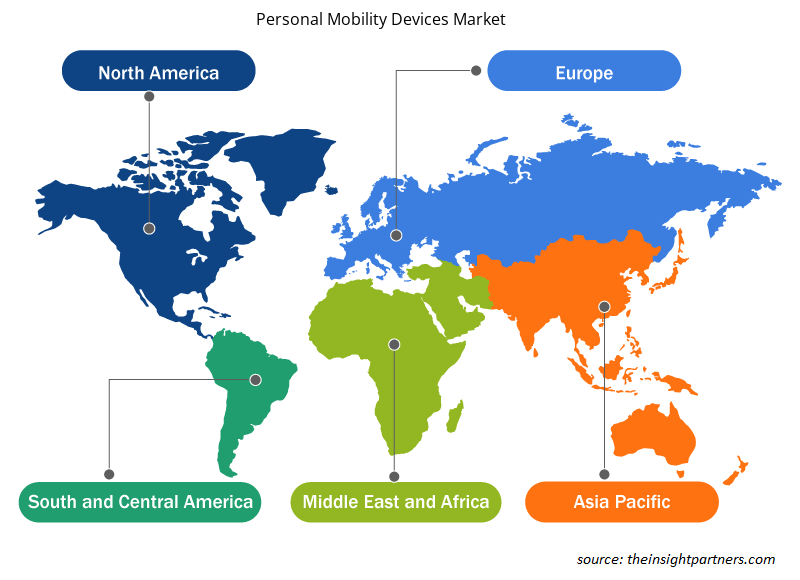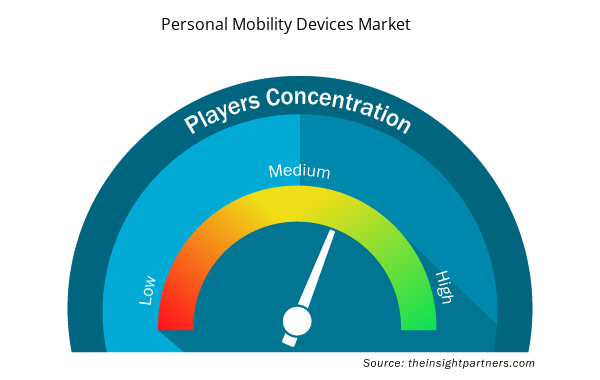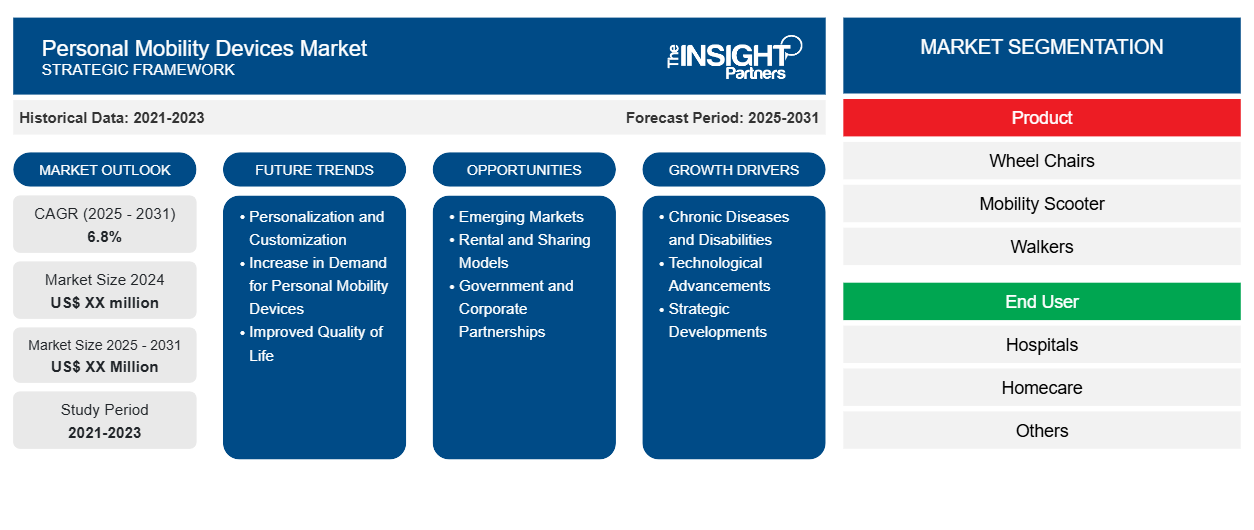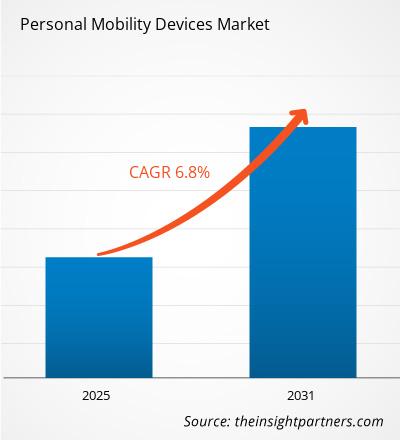Le marché des appareils de mobilité personnelle devrait enregistrer un TCAC de 6,8 % de 2023 à 2031, avec une taille de marché passant de XX millions USD en 2023 à XX millions USD d'ici 2031.CAGR of 6.8% from 2023 to 2031, with a market size expanding from US$ XX million in 2023 to US$ XX Million by 2031.
Le rapport est segmenté par produit (fauteuils roulants, scooters de mobilité, déambulateurs, déambulateurs et autres). L'analyse globale est ensuite décomposée au niveau régional et par principaux pays. Le rapport offre la valeur en USD pour l'analyse et les segments ci-dessus.Rollators and Others). The global analysis is further broken-down at regional level and major countries. The Report Offers the Value in USD for the above analysis and segments.
Objectif du rapport
Le rapport sur le marché des appareils de mobilité personnelle de The Insight Partners vise à décrire le paysage actuel et la croissance future, les principaux facteurs moteurs, les défis et les opportunités. Cela fournira des informations à diverses parties prenantes commerciales, telles que :
- Fournisseurs/fabricants de technologie : pour comprendre l’évolution de la dynamique du marché et connaître les opportunités de croissance potentielles, leur permettant de prendre des décisions stratégiques éclairées.
- Investisseurs : Effectuer une analyse complète des tendances concernant le taux de croissance du marché, les projections financières du marché et les opportunités qui existent tout au long de la chaîne de valeur.
- Organismes de réglementation : Réglementer les politiques et surveiller les activités du marché dans le but de minimiser les abus, de préserver la confiance des investisseurs et de maintenir l’intégrité et la stabilité du marché.
Segmentation du marché des appareils de mobilité personnelle
Produit
- Fauteuils roulants
- Scooter de mobilité
- Les marcheurs
- Déambulateurs et autres
Utilisateur final
- Hôpitaux
- Soins à domicile
- Autres
Personnalisez ce rapport en fonction de vos besoins
Vous bénéficierez d'une personnalisation gratuite de n'importe quel rapport, y compris de certaines parties de ce rapport, d'une analyse au niveau des pays, d'un pack de données Excel, ainsi que de superbes offres et réductions pour les start-ups et les universités.
- Obtenez les principales tendances clés du marché de ce rapport.Cet échantillon GRATUIT comprendra une analyse de données, allant des tendances du marché aux estimations et prévisions.
Facteurs de croissance du marché des appareils de mobilité personnelle
- Maladies chroniques et handicaps : le besoin d'aides à la mobilité est en augmentation en raison de l'incidence croissante de maladies telles que l'obésité, la sclérose en plaques, l'arthrite et les lésions de la colonne vertébrale. Ces gadgets améliorent la qualité de vie des personnes et leur donnent plus d'indépendance. De plus, à mesure que l'espérance de vie augmente dans le monde entier, de plus en plus de personnes âgées ont besoin d'aide pour se déplacer. Le marché des produits tels que les fauteuils roulants électriques, les aides à la marche et les scooters de mobilité est fortement influencé par ce changement démographique.
- Progrès technologiques : Les progrès réalisés en matière de longévité des batteries, de faible poids et de format compact ont rendu les appareils de mobilité personnelle plus efficaces et intuitifs à utiliser. La demande est également stimulée par les technologies intelligentes telles que la commande vocale, l'intégration de l'IoT et la navigation GPS. Honda a créé l'inventif et, il faut l'avouer, l'UNI-ONE, un appareil de mobilité personnelle assis qui fonctionne en mode mains libres. L'utilisateur n'a qu'à ajuster son poids corporel en position assise pour actionner l'assistance électrique, qui est destinée à aider les personnes en bonne santé et celles qui ont des problèmes de mobilité. En gardant les deux mains libres pour se déplacer naturellement dans toutes les directions comme s'il marchait, cela augmente le potentiel de mobilité au-delà de la marche et élargit la gamme d'applications d'un fauteuil roulant traditionnel.IoT integration, and GPS navigation. Honda has created the inventive—and admittedly bizarre—UNI-ONE, a seated personal mobility device that operates hands-free. The user only needs to adjust their body weight while seated to operate the electric assistance, which is intended to assist both healthy individuals and those with mobility problems. By keeping both hands free to move naturally in all directions as if walking this increases mobility potential beyond walking and broadens the range of applications for a traditional wheelchair.
- Développements stratégiques : Afin de réduire les coûts de transport et les délais de livraison, les acteurs du marché mettent également en œuvre un certain nombre d'initiatives stratégiques, telles que le déplacement de leurs empreintes de distribution. Par exemple, le chiffre d'affaires net d'Invacare Corporation a augmenté de 2,6 % entre 2020 et 2021 grâce à des mesures de réduction des coûts dans la chaîne d'approvisionnement et les tâches administratives, ainsi qu'à des programmes mondiaux de modernisation informatique visant à rationaliser la structure organisationnelle de l'entreprise.Invacare Corporation's net sales climbed by 2.6% between 2020 and 2021 as a result of cost-cutting measures in the supply chain and administrative tasks, as well as worldwide IT modernization programs aimed at streamlining the business's organizational structure.
Tendances futures du marché des appareils de mobilité personnelle
- Personnalisation et customisation : De nos jours, les consommateurs préfèrent les appareils de mobilité qui répondent à leurs besoins individuels. Cela a entraîné une tendance croissante à l'utilisation d'appareils plus ou moins esthétiques, confortables ou de grande taille. Pour de nombreuses personnes, la mobilité personnelle est un élément essentiel de la vie quotidienne, et les améliorations apportées à la production d'équipements de mobilité personnelle (PME) ont considérablement amélioré le niveau de vie de ceux qui ont des difficultés à se déplacer. Des fauteuils roulants personnalisés aux scooters de mobilité, le marché évolue constamment pour répondre aux besoins variés des consommateurs. Dans le secteur de la fabrication de PME, la personnalisation est une tendance importante car chaque personne a des besoins et des préférences différents en matière d'aides à la mobilité. Les options de personnalisation des fauteuils roulants sont fournies par les fournisseurs Ostrich Verve FX et Ostrich Pristine, permettant aux utilisateurs d'adapter leur équipement à leurs besoins spécifiques.
- Augmentation de la demande d’appareils de mobilité personnelle : La demande d’appareils de mobilité personnelle innovants et personnalisés augmente, ce qui est de bon augure pour l’avenir de la mobilité personnelle. Les personnes à mobilité réduite peuvent s’attendre à un avenir où leurs besoins seront satisfaits par des solutions de pointe qui améliorent leur qualité de vie grâce aux avancées technologiques et à l’accent mis sur la personnalisation. Donner aux gens la liberté et l’indépendance qu’ils méritent est la mission du secteur manufacturier des appareils de mobilité personnelle, que ce soit par la production de scooters électriques ou de fauteuils roulants personnalisés.
- Amélioration de la qualité de vie : les appareils de mobilité personnelle ont un impact direct et positif sur la qualité de vie des personnes handicapées, des personnes âgées et des personnes à mobilité réduite. Ils offrent une plus grande indépendance et un meilleur bien-être mental. De plus, l'augmentation des appareils de mobilité complète la tendance vers des solutions de soins de santé à domicile. Un plus grand nombre de personnes gérant leur santé à domicile améliore la qualité de vie du patient.
Opportunités de marché pour les appareils de mobilité personnelle
- Marchés émergents : les perspectives de croissance sont énormes dans les pays en développement, où la population vieillit et les connaissances en matière de solutions de mobilité augmentent. La demande d’appareils de mobilité personnelle augmente dans les pays d’Asie-Pacifique, d’Amérique latine et dans certaines régions d’Afrique en raison d’un meilleur accès aux soins de santé et d’un revenu disponible plus élevé. Le marché des appareils de mobilité personnelle devrait croître à un rythme accéléré à mesure que ces opportunités seront exploitées. Les catégories de produits en croissance et les marchés émergents contribueront de manière substantielle à l’expansion du marché.
- Modèles de location et de partage : Le potentiel des locations à court terme ou des appareils de mobilité partagés, similaires aux programmes de partage de vélos et de scooters, s’élargit à mesure que les villes augmentent leur offre dans le domaine de la mobilité. Les voyageurs, les utilisateurs de passage et ceux qui ne peuvent pas se permettre d’avoir leurs propres appareils peuvent tous bénéficier de ces modèles. Plus récemment, trois nouveaux modèles de location de véhicules ont émergé, offrant des opportunités commerciales rentables : la demande croissante de petits véhicules électriques (VE), l’électrification des cyclomoteurs et la popularité croissante des scooters de mobilité.
- Partenariats entre gouvernements et entreprises : les partenariats entre gouvernements, entreprises et fabricants d'appareils peuvent donner lieu à des initiatives d'achats publics, à des initiatives de santé au sein des entreprises et à des subventions. Ces alliances ont le potentiel d'accélérer la pénétration du marché, en particulier dans les domaines où la réglementation en matière de santé est stricte.
Aperçu régional du marché des appareils de mobilité personnelle
Les tendances et facteurs régionaux influençant le marché des appareils de mobilité personnelle tout au long de la période de prévision ont été expliqués en détail par les analystes d’Insight Partners. Cette section traite également des segments et de la géographie du marché des appareils de mobilité personnelle en Amérique du Nord, en Europe, en Asie-Pacifique, au Moyen-Orient et en Afrique, ainsi qu’en Amérique du Sud et en Amérique centrale.

- Obtenez les données régionales spécifiques au marché des appareils de mobilité personnelle
Portée du rapport sur le marché des appareils de mobilité personnelle
| Attribut de rapport | Détails |
|---|---|
| Taille du marché en 2023 | XX millions de dollars américains |
| Taille du marché d'ici 2031 | XX millions de dollars américains |
| Taux de croissance annuel composé mondial (2023-2031) | 6,8% |
| Données historiques | 2021-2022 |
| Période de prévision | 2024-2031 |
| Segments couverts | Par produit
|
| Régions et pays couverts | Amérique du Nord
|
| Leaders du marché et profils d'entreprises clés |
|
Densité des acteurs du marché des appareils de mobilité personnelle : comprendre son impact sur la dynamique des entreprises
Le marché des appareils de mobilité personnelle connaît une croissance rapide, tirée par la demande croissante des utilisateurs finaux en raison de facteurs tels que l'évolution des préférences des consommateurs, les avancées technologiques et une plus grande sensibilisation aux avantages du produit. À mesure que la demande augmente, les entreprises élargissent leurs offres, innovent pour répondre aux besoins des consommateurs et capitalisent sur les tendances émergentes, ce qui alimente davantage la croissance du marché.
La densité des acteurs du marché fait référence à la répartition des entreprises ou des sociétés opérant sur un marché ou un secteur particulier. Elle indique le nombre de concurrents (acteurs du marché) présents sur un marché donné par rapport à sa taille ou à sa valeur marchande totale.
Les principales entreprises opérant sur le marché des appareils de mobilité personnelle sont :
- Marques de santé Carex
- Mobilité+Conçu, LLC
- WHILL Inc.
- Pride Mobility Products Corp.
- Société Invacare.
Avis de non-responsabilité : les sociétés répertoriées ci-dessus ne sont pas classées dans un ordre particulier.

- Obtenez un aperçu des principaux acteurs du marché des appareils de mobilité personnelle
Principaux arguments de vente
- Couverture complète : Le rapport couvre de manière exhaustive l’analyse des produits, des services, des types et des utilisateurs finaux du marché des appareils de mobilité personnelle, offrant un paysage holistique.
- Analyse d’experts : Le rapport est compilé sur la base d’une compréhension approfondie des experts et analystes du secteur.
- Informations à jour : Le rapport garantit la pertinence commerciale en raison de sa couverture des informations récentes et des tendances des données.
- Options de personnalisation : ce rapport peut être personnalisé pour répondre aux exigences spécifiques du client et s'adapter parfaitement aux stratégies commerciales.
Le rapport de recherche sur le marché des appareils de mobilité personnelle peut donc aider à ouvrir la voie au décodage et à la compréhension du scénario de l’industrie et des perspectives de croissance. Bien qu’il puisse y avoir quelques préoccupations valables, les avantages globaux de ce rapport ont tendance à l’emporter sur les inconvénients.
- Analyse historique (2 ans), année de base, prévision (7 ans) avec TCAC
- Analyse PEST et SWO
- Taille du marché Valeur / Volume - Mondial, Régional, Pays
- Industrie et paysage concurrentiel
- Ensemble de données Excel



Report Coverage
Revenue forecast, Company Analysis, Industry landscape, Growth factors, and Trends

Segment Covered
This text is related
to segments covered.

Regional Scope
North America, Europe, Asia Pacific, Middle East & Africa, South & Central America

Country Scope
This text is related
to country scope.
Questions fréquemment posées
The Personal Mobility Devices Market is estimated to witness a CAGR of 6.8% from 2023 to 2031
The major factors driving the Personal Mobility Devices market are:
1.Technological Advancements
2. Chronic Diseases and Disabilities
3. Strategic Developments
North America region dominated the Personal Mobility Devices market in 2023
Asia Pacific region dominated the Personal Mobility Devices market in 2023
The Wheel Chairs
segment accounts for highest revenue in product the Personal Mobility Devices market in 2023
Carex Health Brands, WHILL Inc., Pride Mobility Products Corp, Invacare Corporation, Sunrise Medical (US) LLC accounting for higesh market shares and are some of the major players operating in the market
Trends and growth analysis reports related to Life Sciences : READ MORE..
1. Carex Health Brands
2. Mobility+Designed, LLC
3. WHILL Inc.
4. Pride Mobility Products Corp.
5. Invacare Corporation.
6. Mobility Freedom, Inc.
7. Sunrise Medical (US) LLC
8. Performance Health
9. Rollz International
10. Kaye Products, Inc.
The Insight Partners performs research in 4 major stages: Data Collection & Secondary Research, Primary Research, Data Analysis and Data Triangulation & Final Review.
- Data Collection and Secondary Research:
As a market research and consulting firm operating from a decade, we have published and advised several client across the globe. First step for any study will start with an assessment of currently available data and insights from existing reports. Further, historical and current market information is collected from Investor Presentations, Annual Reports, SEC Filings, etc., and other information related to company’s performance and market positioning are gathered from Paid Databases (Factiva, Hoovers, and Reuters) and various other publications available in public domain.
Several associations trade associates, technical forums, institutes, societies and organization are accessed to gain technical as well as market related insights through their publications such as research papers, blogs and press releases related to the studies are referred to get cues about the market. Further, white papers, journals, magazines, and other news articles published in last 3 years are scrutinized and analyzed to understand the current market trends.
- Primary Research:
The primarily interview analysis comprise of data obtained from industry participants interview and answers to survey questions gathered by in-house primary team.
For primary research, interviews are conducted with industry experts/CEOs/Marketing Managers/VPs/Subject Matter Experts from both demand and supply side to get a 360-degree view of the market. The primary team conducts several interviews based on the complexity of the markets to understand the various market trends and dynamics which makes research more credible and precise.
A typical research interview fulfils the following functions:
- Provides first-hand information on the market size, market trends, growth trends, competitive landscape, and outlook
- Validates and strengthens in-house secondary research findings
- Develops the analysis team’s expertise and market understanding
Primary research involves email interactions and telephone interviews for each market, category, segment, and sub-segment across geographies. The participants who typically take part in such a process include, but are not limited to:
- Industry participants: VPs, business development managers, market intelligence managers and national sales managers
- Outside experts: Valuation experts, research analysts and key opinion leaders specializing in the electronics and semiconductor industry.
Below is the breakup of our primary respondents by company, designation, and region:

Once we receive the confirmation from primary research sources or primary respondents, we finalize the base year market estimation and forecast the data as per the macroeconomic and microeconomic factors assessed during data collection.
- Data Analysis:
Once data is validated through both secondary as well as primary respondents, we finalize the market estimations by hypothesis formulation and factor analysis at regional and country level.
- Macro-Economic Factor Analysis:
We analyse macroeconomic indicators such the gross domestic product (GDP), increase in the demand for goods and services across industries, technological advancement, regional economic growth, governmental policies, the influence of COVID-19, PEST analysis, and other aspects. This analysis aids in setting benchmarks for various nations/regions and approximating market splits. Additionally, the general trend of the aforementioned components aid in determining the market's development possibilities.
- Country Level Data:
Various factors that are especially aligned to the country are taken into account to determine the market size for a certain area and country, including the presence of vendors, such as headquarters and offices, the country's GDP, demand patterns, and industry growth. To comprehend the market dynamics for the nation, a number of growth variables, inhibitors, application areas, and current market trends are researched. The aforementioned elements aid in determining the country's overall market's growth potential.
- Company Profile:
The “Table of Contents” is formulated by listing and analyzing more than 25 - 30 companies operating in the market ecosystem across geographies. However, we profile only 10 companies as a standard practice in our syndicate reports. These 10 companies comprise leading, emerging, and regional players. Nonetheless, our analysis is not restricted to the 10 listed companies, we also analyze other companies present in the market to develop a holistic view and understand the prevailing trends. The “Company Profiles” section in the report covers key facts, business description, products & services, financial information, SWOT analysis, and key developments. The financial information presented is extracted from the annual reports and official documents of the publicly listed companies. Upon collecting the information for the sections of respective companies, we verify them via various primary sources and then compile the data in respective company profiles. The company level information helps us in deriving the base number as well as in forecasting the market size.
- Developing Base Number:
Aggregation of sales statistics (2020-2022) and macro-economic factor, and other secondary and primary research insights are utilized to arrive at base number and related market shares for 2022. The data gaps are identified in this step and relevant market data is analyzed, collected from paid primary interviews or databases. On finalizing the base year market size, forecasts are developed on the basis of macro-economic, industry and market growth factors and company level analysis.
- Data Triangulation and Final Review:
The market findings and base year market size calculations are validated from supply as well as demand side. Demand side validations are based on macro-economic factor analysis and benchmarks for respective regions and countries. In case of supply side validations, revenues of major companies are estimated (in case not available) based on industry benchmark, approximate number of employees, product portfolio, and primary interviews revenues are gathered. Further revenue from target product/service segment is assessed to avoid overshooting of market statistics. In case of heavy deviations between supply and demand side values, all thes steps are repeated to achieve synchronization.
We follow an iterative model, wherein we share our research findings with Subject Matter Experts (SME’s) and Key Opinion Leaders (KOLs) until consensus view of the market is not formulated – this model negates any drastic deviation in the opinions of experts. Only validated and universally acceptable research findings are quoted in our reports.
We have important check points that we use to validate our research findings – which we call – data triangulation, where we validate the information, we generate from secondary sources with primary interviews and then we re-validate with our internal data bases and Subject matter experts. This comprehensive model enables us to deliver high quality, reliable data in shortest possible time.


 Obtenez un échantillon gratuit pour ce rapport
Obtenez un échantillon gratuit pour ce rapport